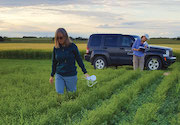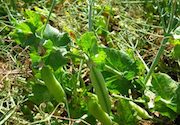| |
| |
 |
 |
| |
 |
|
March 14, 2019 |
|
| |
 As part of its grain grading modernization initiative, the Canadian Grain Commission is inviting grain sector stakeholders to provide input on whether falling number and deoxynivalenol should become official grain grading factors. Stakeholders have until May 10, 2019, to provide input.
» Read more...
As part of its grain grading modernization initiative, the Canadian Grain Commission is inviting grain sector stakeholders to provide input on whether falling number and deoxynivalenol should become official grain grading factors. Stakeholders have until May 10, 2019, to provide input.
» Read more...
A University of Winnipeg research project taking advantage of machine learning for weed identification receives a Weston Seeding Food Innovation grant worth $250,000. The program is now accepting applications for 2019.
» Read more...
Derek Axten presented the practices he’s experimented with on his farm to improve soil health, such as intercropping, at the 2019 Soil Management and Sustainability Summit. In our second Speaker Spotlight video, Axten shares what practices he would recommend and advice for starting something new.
» Read more...
|
| |
 |
 |
| |
|
| |

Three different powerful herbicide Groups have been combined to make one simple solution for cereal growers. Infinity ® FX swiftly takes down over 27 different broadleaf weeds, and now, this innovative resistance-management tool is now available in one convenient co-formulation. One jug for ease of use in tote and bulk packaging.
Infinity FX
- Exceptional activity on weeds including industry-leading control of cleavers (up to 9 whorls) and kochia (up to 15 cm in height)
- Excellent resistance management – with the combined strength of three different herbicide Groups on the same weed species, including Group 27 Pyrasulfotole
- Wide window of application
There’s strength in numbers with Infinity FX.
» Find out how |
| |
|
| |
 Research is catching up to the rise of intercropping in Western Canada. Recent trials looking into chickpea-flax intercrops have shown flax seeding rate has had the biggest impact of the studied agronomic practices. A chickpea-pea intercrop also provides an opportunity for producers who aren’t in a chickpea area to experiment with the high value crop.
» Learn more
Research is catching up to the rise of intercropping in Western Canada. Recent trials looking into chickpea-flax intercrops have shown flax seeding rate has had the biggest impact of the studied agronomic practices. A chickpea-pea intercrop also provides an opportunity for producers who aren’t in a chickpea area to experiment with the high value crop.
» Learn more |
| |
 Ascochyta blight is the most common disease of field pea in Western Canada, producing yield losses of more than 30 per cent. Research conducted by the Manitoba Pulse and Soybean Growers looked at seeding rate and foliar fungicide application impacts on yield, finding that a yield response to a fungicide application was highly dependent on the weather.
» Learn more
Ascochyta blight is the most common disease of field pea in Western Canada, producing yield losses of more than 30 per cent. Research conducted by the Manitoba Pulse and Soybean Growers looked at seeding rate and foliar fungicide application impacts on yield, finding that a yield response to a fungicide application was highly dependent on the weather.
» Learn more |
| |
|
| |
 Selecting what fertilizer best fits your operation can be a difficult process — this likely isn’t a surprise to you. With so many factors playing into the equation, how do you decide what details to consider to ensure your crops get the essential nutrients they need?
» Read more
Selecting what fertilizer best fits your operation can be a difficult process — this likely isn’t a surprise to you. With so many factors playing into the equation, how do you decide what details to consider to ensure your crops get the essential nutrients they need?
» Read more |
| |
|
| |
|
|
| |
| |









